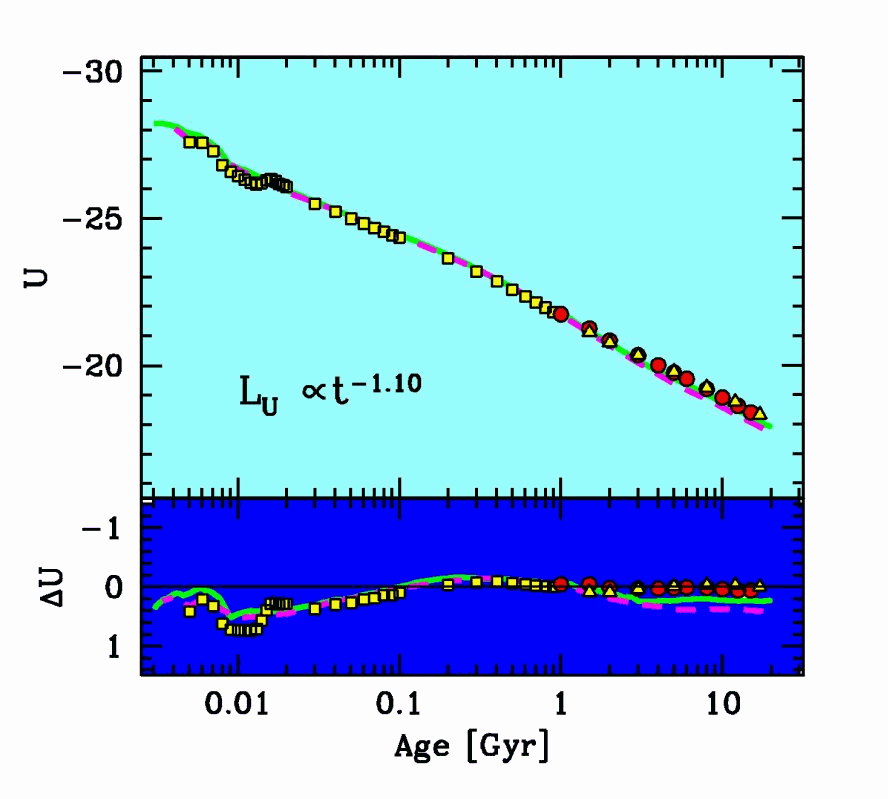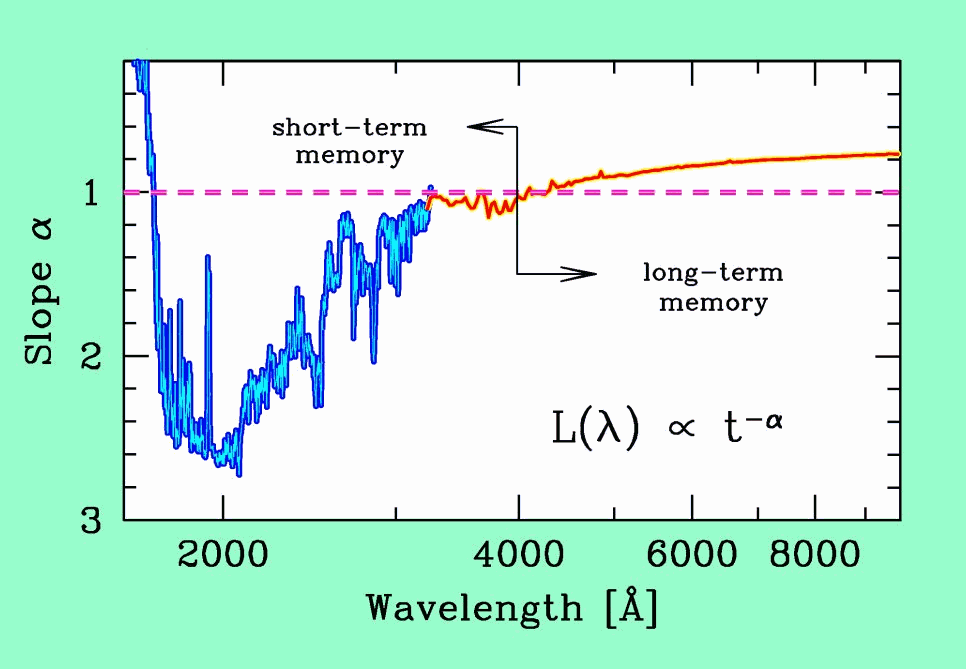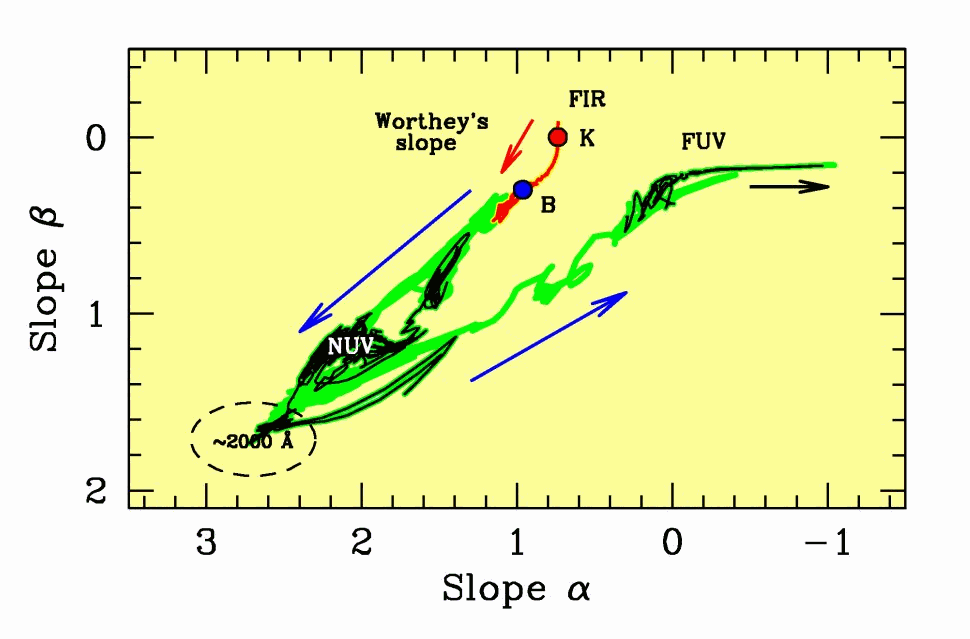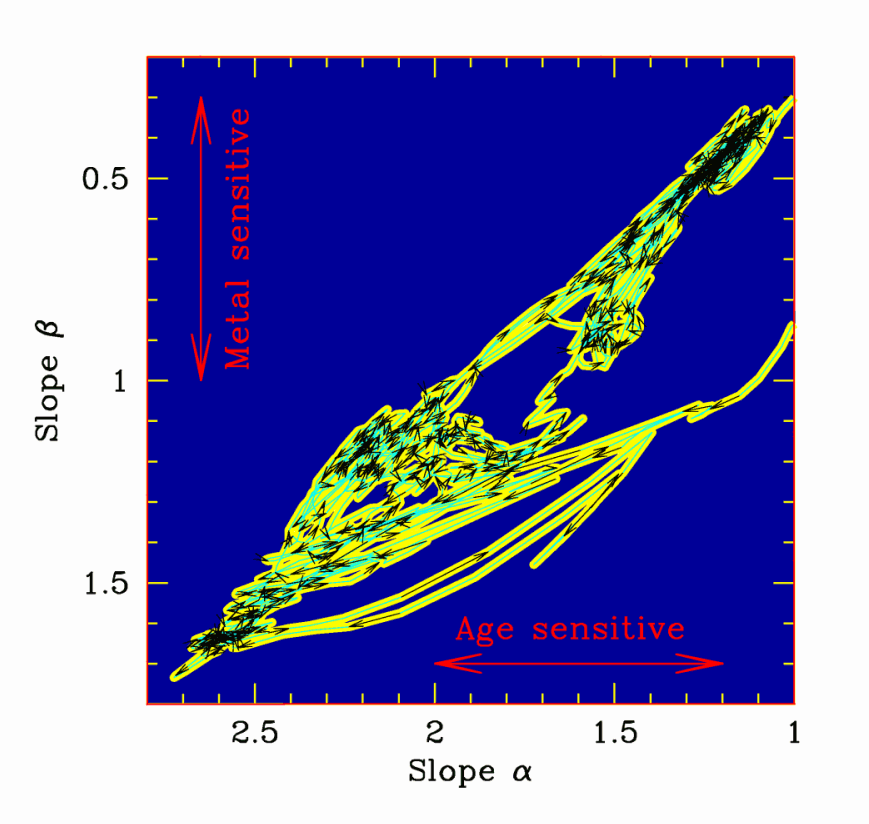Back to article listing

Back to article listing |
 |
Shortcut to the SSP models |
| Buzzoni, A., Bertone, E., Chavez, M. & Rodriguez-Merino, L.H. "Population synthesis at short wavelengths and spectrophotometric diagnostic tools for galaxy evolution",
2007, an invited contribution to the intl. conference "New quests in stellar astrophysics. II: Ultraviolet properties of evolved stellar populations"
(Puerto Vallarta, Mexico, 16-20/Apr/2007), eds. M. Chavez, E. Bertone, L.H. Rodriguez-Merino & D. Rosa-Gonzalez (Springer Verlag: Heidelberg), p.263. |
| Related info to this project can also be found at the local link 1, link 2, and link 3. | ||
|
| Summary: | |||||||||
Taking advantage of recent important advances in the calculation of high-resolution
spectral grids of stellar atmospheres at short-wavelengths, and their implementation
for population synthesis models, we briefly review here some special properties of
ultraviolet emission in SSPs, and discuss their potential applications for identifying and
tuning up effective diagnostic tools to probe distinctive evolutionary properties of
early-type galaxies and other evolved stellar systems.
| |||||||||
With an amazingly successful series of dedicated space missions, the pioneering 70's marked
the beginning of ultraviolet astronomy; satellites like ANS, OAO, and IUE
opened the way, in fact, to the exploration of the nearby Universe at short spectral wavelength
by-passing, for the first time, the blocking effect of Earth atmosphere.
Since then, ultraviolet astronomy has received a renewed impulse in the current decade,
partly due to on-going space projects like the GALEX mission or even the HST,
but also under much different observational circumstances, as more powerful ground-based optical
telescopes made the redshifted short-wavelength emission of distant galaxies to be
eventually detectable at their visual-infrared eyes.
Curiously enough, we ended up by browsing ultraviolet features of galaxies at cosmic distances at much finer detail(*) compared to a still relatively scanty survey of the local stellar systems at wavelengths outside the optical range. For this reason, our understanding of the deep Universe cannot fully rely on a straightforward application of the local empirical templates, but rather needs an added value by theory to assess the evolution of high-redshift of stellar populations. In this regard, population synthesis has attained nowadays an unprecedented accuracy in reproducing galaxy spectral features thanks to the match with increasingly refined libraries of stellar model atmospheres and improved algorithms to derive therefrom the high-resolution spectral information across the widest range of fundamental parameters (i.e. log Teff, log g and [Fe/H]). As far as the short-wavelength range is concerned (i.e. for λ ≤ 3000 Å) we can presently count on important theoretical datasets covering the full parameter space to reproduce stellar spectral energy distribution (SED) across the whole H-R diagram, at wavelength resolution typically better than λ/Δλ ≥ 20000 (see Bertone 2005, for an exhaustive review on this subject. Among others, these include the work of Rodriguez-Merino et al. (2005) (UVBLUE spectral library), Gustaffson et al. (2003) (MARCS model grid), Munari et al. (2005), Hauschildt et al. (1999) (the NextGen library), and Coelho et al. (2005). As an effort to settle the interpretative framework that stems from the analysis of the short-wavelength SED of stellar systems, in this contribution we want to briefly review some special properties of ultraviolet emission in simple stellar populations (SSPs), and discuss their potential applications for identifying and tuning up effective diagnostic tools for population synthesis studies. (*) In addition, redshift acts on spectroscopic observations by improving wavelength resolution λ/Δλ by a factor (1+z) in the galaxy restframe.
| |||||||||
 (click on the figures to enlarge) Figure 1 -
Theoretical SSP luminosity evolution for solar metallicity and Salpeter IMF, according to different
population synthesis codes, namely Buzzoni (1989, and 2005) (dots), Worthey (1994) (triangles), Leitherer et al. (1999)
(squares), Bressan et al. (1994) (dashed line), and Bruzual & Charlot (2003) (solid line). Absolute U magnitudes are
scaled to a total SSP mass of 1011 Msun. For each model sequence,
the residuals with respect to a perfect LU ∝t−1.10 trend are shown in the lower panel.
| |||||||||
It is commonly recognized that UV luminosity carries direct information on the age of young SSPs,
being sensitive to the presence of hot and bright high-mass stars at the top main sequence
(MS) turn-off (TO) point (e.g. O'Connell 1999). While this certainly holds for a starburst case,
where colors like U−V are actually fair age tracers (see, e.g., Leitherer et al. 1999;
Mas-Hesse & Kunth 1991), things can be different, and subtly more entangled, in case star
formation (SF) proceeds allover the galaxy life.
The key feature in this framework resides in a physically different "regime" of UV luminosity evolution compared to longer wavelengths. As far as the Johnson U band is concerned, for instance, models indicate that, for a solar metallicity and a Salpeter slope for the power-law IMF, SSP luminosity scales with time as
(e.g., Buzzoni 2005). This holds over virtually the whole SSP history, from ages of a few Myr up to 10 Gyr and beyond (see Fig. 1). If we assemble several equally mass-weighted SSPs (each producing stars up to a mass Mup with a fixed IMF) along a wider age range such as to smoothly reproduce a constant SF rate over time t, then the total luminosity of the resulting composite stellar population (CSP) becomes
In the equation, to is the lifetime of stars of highest mass, Mup, and can be operationally (and physically) conceived as the discrete integration time step dτ in each summation. If α < 1, one sees that the r.h. solution of the integral is actually modulated by the oldest SSP components (that is those stars about t years old) as, in general, t1−α » to1−α. On the contrary, if the SSP luminosity fades more rapidly than LSSP ∝ t−1, that is for α > 1, then the term to(1−α) prevails and most of CSP luminosity comes from the youngest composing SSPs. In the latter case,
and the integrated CSP luminosity looses any dependence on age, only responding to the amount of short-lived high-mass stars, as modulated by the actual SF rate of the stellar aggregate (see Buzzoni 2002, for a more detailed discussion). For the case of the U band α = 1.1, and this is why ultraviolet luminosity is a so effective tracer of the actual SF activity carrying therefore "short-term" memory of the CSP history. More generally, α is expected to vary as a function of wavelength, as well, as the slope in the log L vs. log t relationship for a SSP depends on the relative contribution to total luminosity of stars in the different regions of the H-R diagram. For the same reference SSP of Fig. 1, this is shown in Fig. 2 along the full spectral range. From the figure, one notes for example that eq. (3) holds along the entire mid-UV wavelength range, being α > 1 for λ ≥ 4000 Å. On the contrary, the visual and infrared ranges characterize for a shallower SSP luminosity evolution (α < 1). When applied to the case of a CSP, therefore, colors like V−K are expected to carry "long-term" memory of CSP history through the cumulative effect of long-lived unevolved stars of low mass along the entire life of the stellar system.
| |||||||||
 (click on the figures to enlarge) Figure 2 -
Expected change with wavelength of the slope α = −∂ log L(λ)/∂ log t
for a 15 Gyr SSP with solar metallicity, Salpeter IMF, and a red horizontal branch morphology,
according to Buzzoni (1989). High-resolution UV synthesis made use of the UVBLUE
spectral library of Rodriguez-Merino et al. (2005). Note that α exceeds unity in the ultraviolet
spectral region shortward of 4000 Å. As discussed in the text, this threshold value discriminates between
two different regimes for SSP luminosity evolution.
| |||||||||
|
The transition between short- and long-term memory regimes along SED of a CSP will also depend on the IMF details.
Compared to the Salpeter case, for example, a stellar aggregate displaying a steeper
(i.e. giant-dominated) IMF power slope would more likely wipe out any sign of its more remote past
being populated at any time, on average, by shorter-lived higher-mass stars.
In this case, α will exceed unity well longward of λ~4000 Å.
| |||||||||
|
In spite of any more or less exotic recipe to combine stellar tracks and isochrones,
from the physical point of view, the ultimate driving parameter that eventually constrains SED
of a SSP is the mass of TO stars (MTO). The latter will in fact set the cosmic clock
(through MS stellar lifetimes) and reverberate on the overall morphology of the different
evolutionary stages across the synthetic H-R diagram of the SSP. As a major drawback of this situation,
anytime we try to derive an absolute age estimate for the (either resolved or unresolved) SSP we also need to
set it at the same time its chemical composition. In other words, age
and metallicity are intimately tied such as a wide range of SSPs can in principle give rise
to fully equivalent spectrohotometric outputs.
More generally, synthesis models have extensively demonstrated that "a factor of three change in age produces the same change in most colors and indices as a factor of two in Z'' (Worthey 1992). So, old metal poor SSPs closely resemble in color and overall SED younger metal-rich ones. This effect, known as the "age-metallicity degeneracy" (Renzini & Buzzoni 1986; Buzzoni 1995), cannot easily be overcome as far as we restrain our analysis to the optical range of the SED of stellar systems, and we are forced therefore to browse the most extreme spectral windows, both at shorter and longer wavelength range, to break the "3-to-2" degeneracy and decouple, in principle, the t and Z pieces of information in SSPs. In this regard, ultraviolet is certainly a preferred window, in force of the more selective dependence of SSP luminosity on the upper MS stellar component. Again, taking the SED of a 15 Gyr Salpeter SSP of solar metallicity as a reference, we have estimated in Fig. 3 the expected changes of total monochromatic luminosity along the entire SED vs. a change either in metallicity or age, assuming that
Worthey's steep slope Δβ/Δα = ∂ log t /∂ log Z ~ log 3/ log 2
can easily be recognized for a long wavelength path spanning from the near infrared to the optical
window, but a more complex behaviour begins to appear in the ultraviolet, especially in the Mid-UV range
around the spectral region that roughly corresponds to the GALEX NUV pass-band, as displayed
on the plot. The β vs. α curve then turns about 2000 Å changing direction
with decreasing λ and eventually flattening shortward of 1500 Å.(**)
(**) Note that, contrary to the visual wavelenght range, age-metallicity degeneracy shortward of 2000 Å behaves in the opposite way,
as the effect on FUV colors of a younger SSP can be recovered by decreasing metallicity.
| |||||||||
 (click on the figures to enlarge) Figure 3 -
Theoretical estimate of α = −∂ log L(λ)/∂ log t and
β = −∂ log L(λ)/∂ log Z slopes with varying wavelength from the
infrared (Johnson K band at 2.2 μm) to the far ultraviolet (λ~1500 Å),
as indicated by the arrows, for the reference SSP of Fig. 2. Johnson B and K wave bands are labelled
for reference on the plot, as well as the GALEX Far- (FUV) and Near-UV (NUV) bands. Note the turn-around feature about 2000 Å,
and an opposite trend of the β vs. α relationship when moving toward the Far-UV spectral range.
The Worthey (1992) "3-to-2" degeneracy vector is displayed on the plot (see text for a discussion).
| |||||||||
|
The recent theoretical grids of synthetic stellar atmospheres, covering the short-wavelength range
at high spectral resolution, have made possible to directly trace the evolution of specific spectral features
along the ultraviolet region of the SED of synthetic stellar atmospheres.
In particular, the mid-UV (i.e. 2200 ≤ λ ≤ 3200 Å) wavelength range has been carefully screened by Chavez et al. (2007), based on the Rodriguez-Merino et al. (2005) UVBLUE spectral grid. The Chavez et al. analysis tackles, from the theoretical side, the original work of Fanelli et al. (1990), who carried out a comprehensive analysis of IUE stellar database through a set of narrow-band spectrophotometric indices able, in principle, to independently probe temperature, surface gravity, and chemical composition of stars. The big advantage of the theoretical approach, over the empirical one, however, is that one can more comfortably explore the change of spectral features with varying (in a controlled way) either one or more of the stellar fundamental parameters. In addition, also obvious limits of empirical samples can be overcome, like for instance the narrow range of [Fe/H] distribution, naturally peaked around the solar value when observing real stars in the solar neighbourhood. The Chavez et al. (2007) theoretical framework has been further extended, by matching the UVBLUE spectral library with the Buzzoni (1989) population synthesis code to obtain synthetic UV indices for SSPs. Full details of this project are the subject of a forthcoming paper Bertone et al. (2007), but we want to assess here just a few important issues related to a more refined use of narrow-band indices á la Fanelli to probe evolutionary parameters of stellar populations. According to our previous discussion, as far as SSPs are concerned, the mid-UV spectral region appears to be the most promising one to break the "3-to-2" age-metallicity degeneracy. On a narrow-band wavelength scale like in Fig. 4, in fact, one can appreciate that the β vs. α correlation drastically deviates from the Worthey's slope, providing any sort of spectral "leverage" suitable to provide decoupled or even orthogonal pieces of information about age and metallicity. In this regard, by properly chosing both feature and pseudo-continuum bands, such as to have either a prevailing dependence on β or α, one could set up, in principle, new and optimzed narrow-band indices either metal- or age-sensitive, respectively.
| |||||||||
 (click on the figures to enlarge) Figure 4 -
A zoomed plot of the UV region from Fig. 3, sketching the trend of the
Δβ/Δα = ∂ log t /∂ log Z degeneracy vector along
wavelength, from 3000 Å (top right corner) to ~1500 Å (mid-range curve to the right).
According to the slope of the β vs. α relation, the different intervals of the UV SED
can be selectively sensitive to either age (Δβ → 0) or metallicity changes
(Δα → 0).
| |||||||||
|
On the same line, by means of Fig. 4 we could easily probe age- and metal-sensitivity of
established narrow-band indices, like those in the Fanelli et al. (1990) system as well.
Two interesting examples of nearly "horizontal" (i.e. most age-sensitive) and "vertical"
(i.e. most metal-sensitive) indices are displayed in Fig. 5, for the case of the
2332 Å Fe II feature and for the 2538 Å metal blend.
Given its manifold piece of information, we are going to more systematically explore β vs. α diagnostic diagrams like those of Fig. 4 in order to identify and exploit potentially useful features to more cleanly probe distinctive properties of stellar population relying on the spectroscopic analysis of their integrated UV spectrum. To a more refined approach, however, such an excercise needs to more accurately size up the influence on Fig. 4 of theoretical uncertainties in high-resolution UV spectral synthesis, as well as the impact of other distinctive parameters of stellar aggregates, like the horizontal branch morphology, α-enhanced chemical partitions, and different slopes in the power-law IMF.
| |||||||||
|
| |||||||||
|
Acknowledgments - We are pleased to acknowledge partial financial support for this project
from Italian MIUR, under grant INAF PRIN/05 1.06.08.03, and from Mexican CONACyT, via grants 36547-E and
SEP-2004-C01-47904.
| |||||||||
|
Bertone, E. 2005, Mem. SAIt Suppl. Ser., 8, 180 | |||||||||
Back to article listing |
 |
Shortcut to the SSP models |
| AB/Sep 2007 |